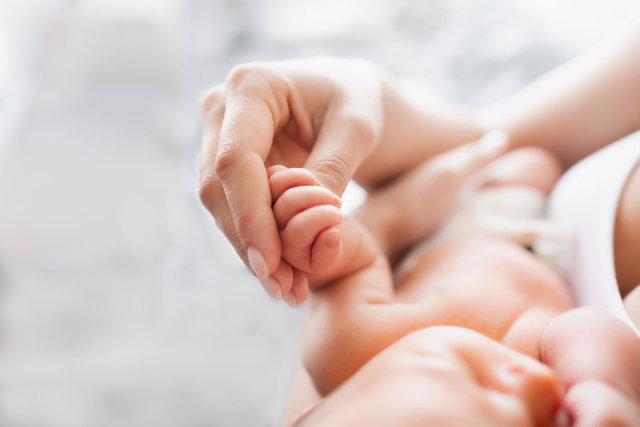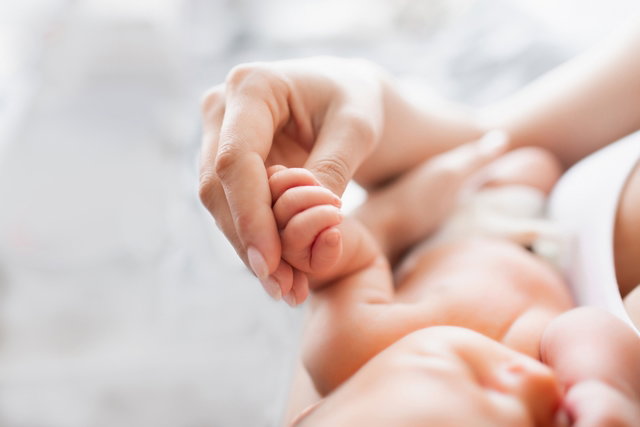The phases of normal labor occur in a row and generally include dilation of the cervix, expulsion period and delivery of the placenta. Generally, labor begins spontaneously between 37 and 40 weeks of gestation and there are signs that indicate that the pregnant woman is going into labor, such as the expulsion of the mucous plug, which is the release of a gelatinous liquid. , pinkish or brownish from the vagina and the rupture of the water bag, which is when the clear amniotic fluid begins to come out.
Furthermore, the pregnant woman begins to have irregular contractions, which intensify, until they become regular and every 10 minutes apart. Learn how to identify contractions.
Therefore, when a pregnant woman has these symptoms she should go to the hospital or maternity ward, as the birth of the baby is close.

1st Phase – Dilation
The first stage of labor is characterized by the presence of contractions and the process of dilation of the cervix and birth canal until it reaches 10 cm.
This phase is divided into latentin which the dilation of the cervix is less than 5 cm and is characterized by a gradual increase in uterine activity, the presence of irregular uterine contractions and an increase in cervical secretions, with loss of the mucous plug, and activein which dilation is greater than 5 cm and the woman begins to experience regular and painful contractions.
The duration of the first stage of labor can vary from woman to woman, however it lasts on average 8 to 14 hours. During this period, it is common for women to feel pain due to contractions, which become more regular and with a shorter interval between them as the cervix and vaginal canal dilate further.
What to do at this stage: At this stage, the pregnant woman must go to the maternity ward or hospital to receive assistance from health professionals. To reduce pain, pregnant women should inhale slowly and deeply during each contraction, as if they were smelling a flower and exhale as if they were blowing out a candle.
In addition, you can walk slowly or climb stairs, as this will help the fetus to position itself to exit and, if the woman is lying down, she can turn to her left side, to facilitate better oxygenation of the fetus and reduce pain. Discover other natural ways to induce labor.
In the hospital, during the first stage of labor, a vaginal examination is performed every 4 hours to monitor dilation and encourage movements to the vertical position. Furthermore, in the case of women who are at low risk of needing general anesthesia, the intake of liquids and food is permitted.
2nd Phase – Expulsion
The active phase of labor continues through the expulsion phase, in which the cervix has already reached maximum dilation and the expulsion phase begins, which can take between 2 and 3 hours.
The beginning of the expulsion phase is called the transition period, which is relatively short and quite painful and the cervix dilates between 8 and 10 cm at the end of the period. When adequate dilation is verified, the woman should begin to push for the descent of the fetal presentation. Furthermore, the position for the birth can be chosen by the pregnant woman, as long as she is comfortable and that it favors the second phase of labor.
What to do at this stage: During this phase, the woman must follow the instructions given to her to promote childbirth. Therefore, it is recommended that the woman perform the pushing movement following her own thrust, in addition to it being important to keep her breathing controlled.
During this phase, some techniques can also be performed to reduce trauma to the perineum, such as perineal massage, hot compresses or perineal protection with the hands. Manual pressure on the cervix or episiotomy is not recommended, which corresponds to making a small cut in the perineum to facilitate birth.
Although episiotomy is a recurrent practice, its performance is not recommended in women who do not have an indication, this is because the benefits of this technique are contradictory and there is not sufficient scientific evidence, in addition to the fact that it has been observed that carrying out this procedure routinely does not It promotes protection for the pelvic floor and is the main cause of pain, bleeding and complications during and after childbirth.
3rd Phase – Delivery: Delivery of the placenta
The delivery phase is phase 3 of labor and occurs after the birth of the baby, and is characterized by the exit of the placenta, which can come out spontaneously or be removed by the doctor. At this stage, oxytocin is normally administered, which is a hormone that promotes labor and the birth of the baby.
What to do at this stage: At this stage, after the baby is born, the obstetrics and nursing team will carry out a general assessment of the woman, in addition to carrying out controlled traction of the umbilical cord.
After birth and in the absence of signs of complications in the mother or baby, the newborn is placed in contact with the mother for the first breastfeeding.

Sign up for our newsletter and stay up to date with exclusive news
that can transform your routine!
Warning: Undefined array key "title" in /home/storelat/public_html/wp-content/plugins/link-whisper-premium/templates/frontend/related-posts.php on line 12
Warning: Undefined array key "title_tag" in /home/storelat/public_html/wp-content/plugins/link-whisper-premium/templates/frontend/related-posts.php on line 13




